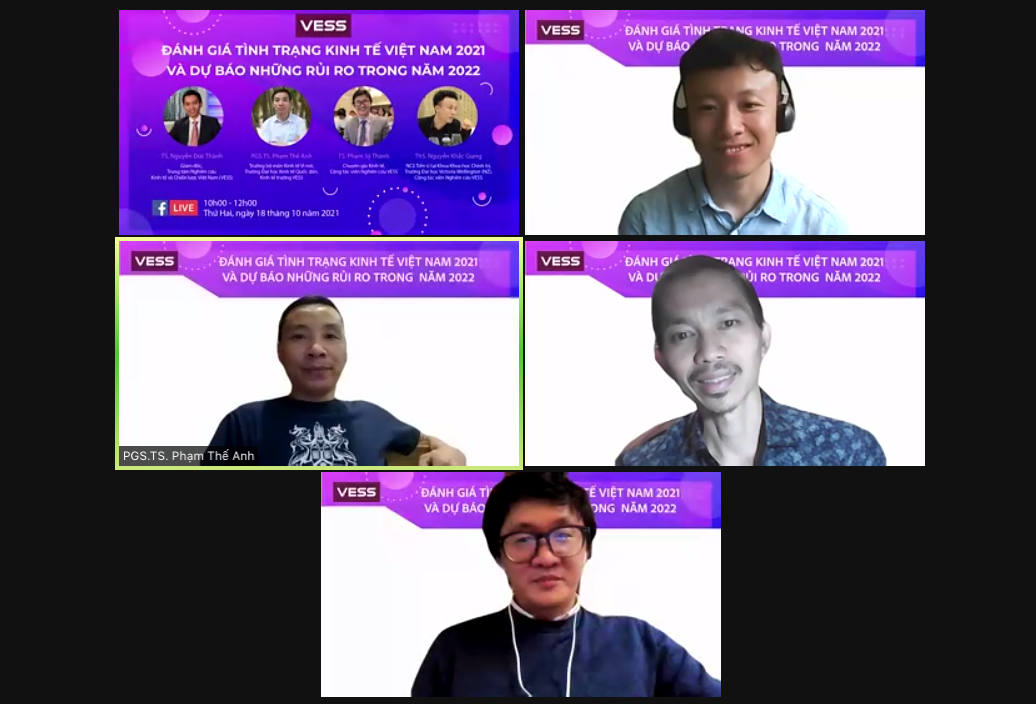Vietnam GDP growth predicted to hit 1.8% in 2021: VESS
Vietnam’s growth prospects remain much dependent on the effectiveness of vaccination programs, restriction measures, and the implementation of supporting policies.
Vietnam’s GDP is likely to expand by 1.8% in 2021 following the recent fourth Covid-19 outbreak that forces major cities in the country into lockdown for months.
| Overview of the virtual talk. HNT Photo: Nguyen Tung |
Construction and industry would be the main driving force for growth by contributing four percentage to the total, followed by agro-forestry-fishery with 2.5 percentage points.
This was one of the two growth scenarios provided by the Director of the Vietnam Center for Economic and Strategic Studies (VESS) Nguyen Duc Thanh in a virtual talk held today [October 18] to discuss Vietnam’s economic prospects in 2021 and risks in 2022.
“The 1.8% GDP growth would be achieved based on the assumption that all localities agree on a single set of measures for safe adaptation to the Covid-19 and ensure smooth movements of goods and products in the remainder of the year,” Thanh said.
In this case, Thanh expected economic activities would gradually return to normal, while all major cities would complete their respective vaccination program in the first half of the fourth quarter.
“A key condition is that there would be no repeat of lockdown in a similar level to the previous quarter,” Thanh suggested.
In a less optimistic case, however, Vietnam’s GDP growth would remain positive but significantly lower by 0.2%.
“This would come from a situation that the pandemic would return in certain provinces/cities that later leads to mobility restriction, along with lack of consistency in the implementation of government policies in efforts to adapt to the Covid-19 situation,” he added.
According to Thanh, in this scenario, the repeated lockdown in some localities would cause risks of unsettling businesses and firms may continue to shift their orders to other countries due to the disruption of supply chains.
Due to a large number of people leaving major cities to return to their hometown, the Director of VESS expressed concern that the labor shortage could persist until the first quarter of 2022 and impacts the economic recovery process.
“High production cost could complicate the situation and limit chance for businesses to survive,” Thanh said.
On this issue, VESS Chief Economist Pham The Anh said the Government should stay cautious at high inflationary pressure due to rising production costs.
“Hiking prices of input materials, logistics, petroleum products would eventually translate into prices of final goods. Once social activities return to normal, consumption demand is set to go up and lead to an expansion of inflation rate,” The Anh asserted.
“Under this context, prices of foodstuff may be the first to rise in later this year, not to mention the upcoming flooding season in Vietnam’s central region,” he added.
Policy implication
To ensure macro-economic conditions staying intact, VESS Director Thanh urged the government to continue prioritizing nationwide vaccination programs.
“This is the prerequisite to ensure people and goods mobility,” he added.
Meanwhile, the Government should provide supporting packages focusing on infrastructure development and enhancing the capability of the healthcare system.
“Local authorities should promptly address the needs of people losing jobs to avoid a possible collapse of the social welfare system,” Thanh said.
Regarding the monetary policy, Thanh said it remains essential for the banking sector to meet the capital needs of the economy while urging that steps be taken to keep the money supply at around 10%, along with moderate risk control.
He refuted the idea of mobilizing idle dollars or gold from the people, saying such a move may cause an unstable macroeconomy.
“The mobilization of social resources should only be carried out via interest rates and existing instruments in the finance market” he concluded.












